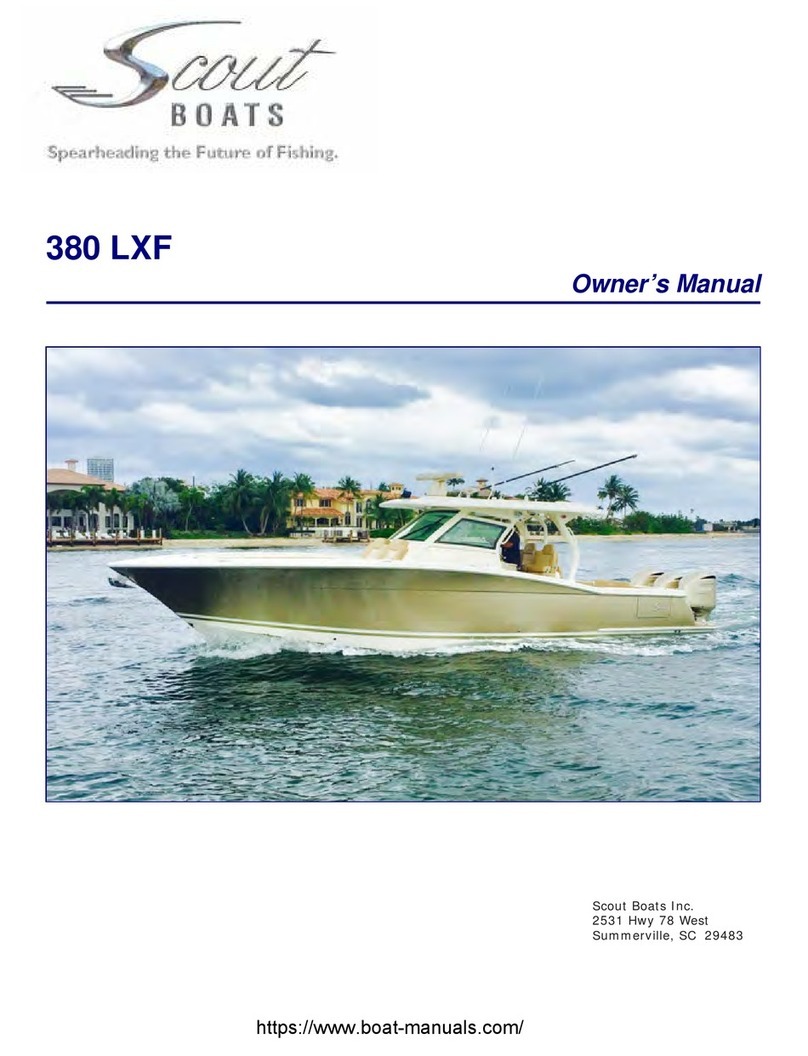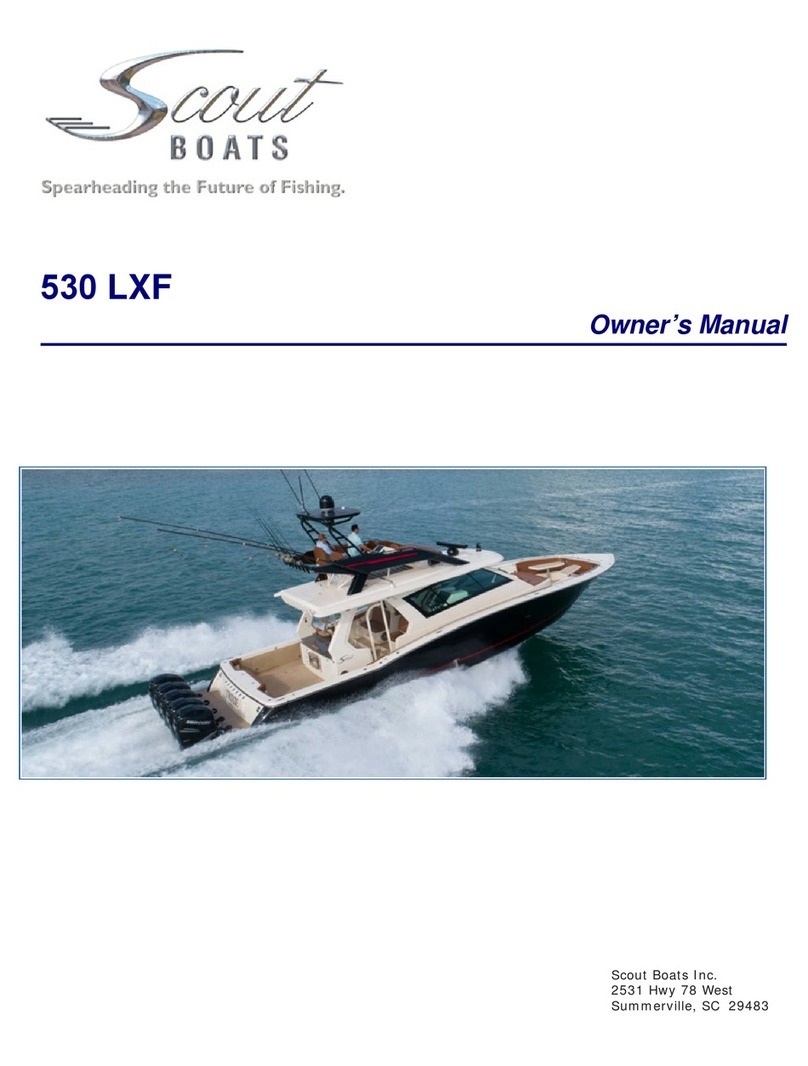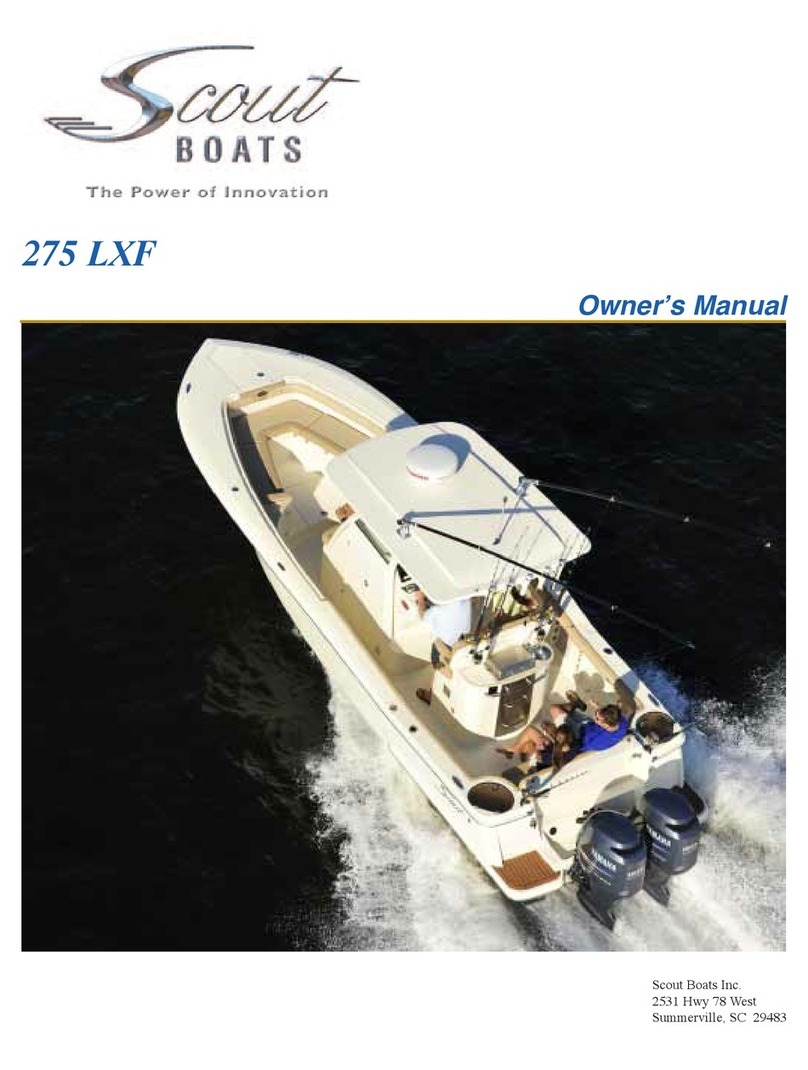
20
Safety Equipment
Notice:
You should carry an extra stop switch lan-
yard and instruct at least one other crew
member on the operation of the stop switch
and location of the extra lanyard.
1.5 Required Safety Equipment
Besides the equipment installed on your boat by
Scout, certain other equipment is required by
the U.S. Coast Guard to help ensure passenger
safety. Items like a sea anchor, working anchor,
extra dock lines, are pistol, life vests, a line per-
manently secured to your ring buoy, etc. could at
some time save your passengers’ lives or save
your boat from damage. Refer to the “Federal
Requirements and Safety Tips for Recreational
Boats” pamphlet for a more detailed description
of the required equipment. You also can visit the
U.S. Coast Guard Boating Safety web site, www.
uscgboating.org, for information on boat safety
courses and brochures listing the Federal equip-
ment requirements. Also, check your local and
state regulations.
The Coast Guard Auxiliary oers a “Courtesy Ex-
amination.” This inspection will help ensure that
your boat is equipped with all of the necessary
safety equipment.
The following is a list of the accessory equipment
required on your boat by the U.S. Coast Guard:
Personal Flotation Devices (PFDs)
PFDs must be Coast Guard approved, in good and
serviceable condition, and of appropriate size for
the intended user. Wearable PFDs must be read-
ily accessible, meaning you must be able to put
them on in a reasonable amount of time in an
emergency. Though not required, the Coast Guard
emphasizes that PFDs should be worn at all times
when the vessel is underway. Throwable devices
must be immediately available for use. All Scout
boats must be equipped with at least one Type I,
II or III PFD for each person on board, plus one
throwable device (Type IV).
Please note that most state laws now require that
children 13 years old and under must wear a PFD
at all times.
Visual Distress Signals
All Scout boats used on coastal waters, the Great
Lakes, territorial seas, and those waters connected
directly to them, must be equipped with Coast
Guard approved visual distress signals. These
signals are either Pyrotechnic or Non-Pyrotechnic
devices.
Pyrotechnic Visual Distress Signals
Pyrotechnic visual distress signals must be Coast
Guard approved, in serviceable condition, and
readily accessible. They are marked with a date
showing the service life, which must not have
expired. A minimum of three are required. Some
pyrotechnic signals meet both day and night use
requirements. They should be stored in a cool,
dry location. They include:
• Pyrotechnic red ares, hand held or aerial.
• Pyrotechnic orange smoke, hand-held or oat-
ing.
• Launchers for aerial red meteors or parachute
ares.
PYROTECHNICS ARE UNIVERSALLY RECOGNIZED AS
EXCELLENT DISTRESS SIGNALS. HOWEVER, THERE IS
POTENTIAL FOR INJURY AND PROPERTY DAMAGE IF NOT
PROPERLY HANDLED. THESE DEVICES PRODUCE A VERY
HOT FLAME AND THE RESIDUE CAN CAUSE BURNS AND
IGNITE FLAMMABLE MATERIAL. PISTOL LAUNCHED AND
HAND-HELD PARACHUTE FLARES AND METEORS HAVE
MANY CHARACTERISTICS OF A FIREARM AND MUST BE
HANDLED WITH CAUTION. IN SOME STATES THEY ARE
CONSIDERED A FIREARM AND PROHIBITED FROM USE.
ALWAYS BE EXTREMELY CAREFUL AND FOLLOW THE
MANUFACTURER’S INSTRUCTIONS EXACTLY WHEN USING
PYROTECHNIC DISTRESS SIGNALS.
Non-Pyrotechnic Devices
Non-Pyrotechnic visual distress signals must be
in serviceable condition, readily accessible, and
certied by the manufacturer as complying with
U.S. Coast Guard requirements. They include:
• Orange Distress Flag. (Day use only)
The distress ag is a day signal only. It must
be at least 3 x 3 feet with a black square and
ball on an orange background. It is most
distinctive when attached and waved from a
paddle or boat hook.

























































